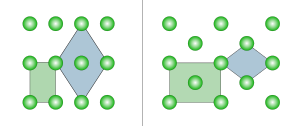In crystallography, the orthorhombic crystal system is one of the 7 crystal systems. Orthorhombic lattices result from stretching a cubic lattice along two of its orthogonal pairs by two different factors, resulting in a rectangular prism with a rectangular base (a by b) and height (c), such that a, b, and c are distinct. All three bases intersect at 90° angles, so the three lattice vectors remain mutually orthogonal.
Bravais lattices

Two-dimensional
In two dimensions there are two orthorhombic Bravais lattices: primitive rectangular and centered rectangular. The primitive rectangular lattice can also be described by a centered rhombic unit cell, while the centered rectangular lattice can also be described by a primitive rhombic unit cell.
Three-dimensional
In three dimensions, there are four orthorhombic Bravais lattices: primitive orthorhombic, base-centered orthorhombic, body-centered orthorhombic, and face-centered orthorhombic.
In the orthorhombic system there is a rarely used second choice of crystal axes that results in a unit cell with the shape of a right rhombic prism;[1] it can be constructed because the rectangular two-dimensional base layer can also be described with rhombic axes. In this axis setting, the primitive and base-centered lattices swap in centering type, while the same thing happens with the body-centered and face-centered lattices. Note that the length in the lower row is not the same as in the upper row, as can be seen in the figure in the section on two-dimensional lattices. For the first and third column above,
of the second row equals
of the first row, and for the second and fourth column it equals half of this.
Crystal classes
The orthorhombic crystal system class names, examples, Schönflies notation, Hermann-Mauguin notation, point groups, International Tables for Crystallography space group number,[2] orbifold notation, type, and space groups are listed in the table below.
| This article uses material from the Wikipedia article Metasyntactic variable, which is released under the Creative Commons Attribution-ShareAlike 3.0 Unported License. |





